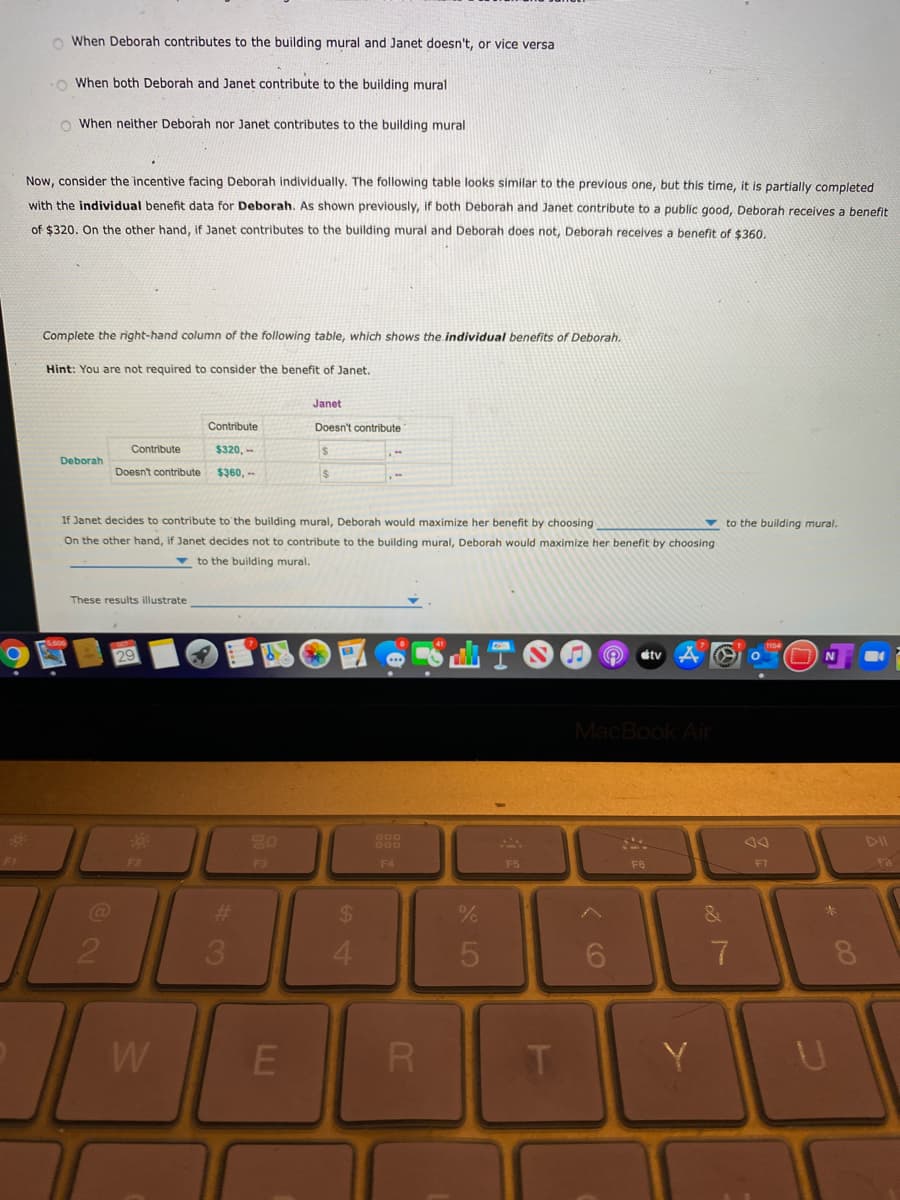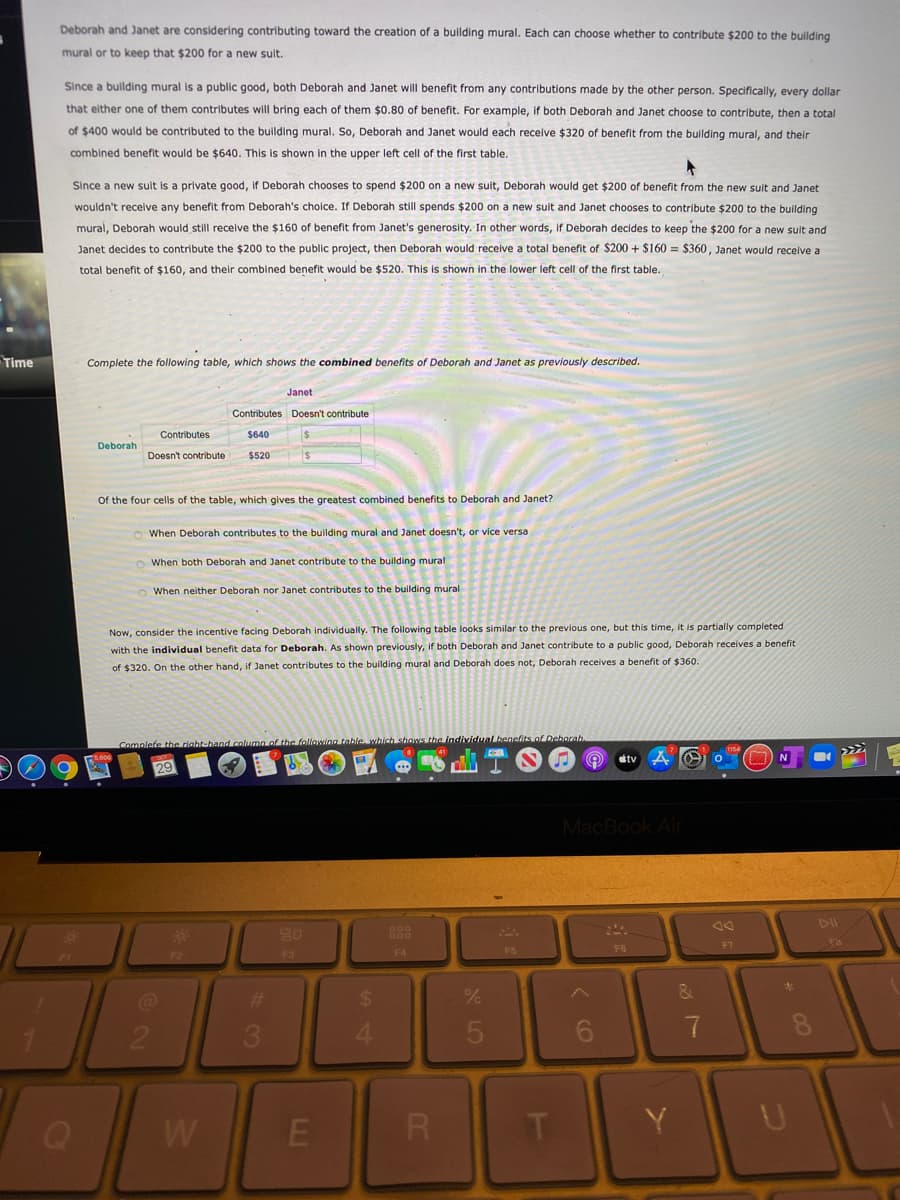Deborah and Janet are considering contributing toward the creation of a building mural. Each can choose whether to contribute $200 to the building mural or to keep that $200 for a new sult. Since a building mural is a public good, both Deborah and Janet will benefit from any contributions made by the other person. Specifically, every dollar that either one of them contributes will bring each of them $0.80 of benefit. For example, if both Deborah and Janet choose to contribute, then a total of $400 would be contributed to the building mural. So, Deborah and Janet would each receive $320 of benefit from the building mural, and their combined benefit would be $640. This is shown in the upper left cell of the first table. Since a new sult is a private good, if Deborah chooses to spend $200 on a new suit, Deborah would get $200 of benefit from the new suit and Janet wouldn't recelve any benefit from Deborah's cholce. If Deborah still spends $200 on a new suit and Janet chooses to contribute $200 to the building mural, Deborah would still recelve the $160 of benefit from Janet's generosity. In other words, If Deborah decides to keep the $200 for a new suit and Janet decides to contribute the $200 to the public project, then Deborah would receive a total benefit of $200 + $160 = $360, Janet would receive a total benefit of $160, and their combined benefit would be $520. This is shown in the lower left cell of the first table.
Deborah and Janet are considering contributing toward the creation of a building mural. Each can choose whether to contribute $200 to the building mural or to keep that $200 for a new sult. Since a building mural is a public good, both Deborah and Janet will benefit from any contributions made by the other person. Specifically, every dollar that either one of them contributes will bring each of them $0.80 of benefit. For example, if both Deborah and Janet choose to contribute, then a total of $400 would be contributed to the building mural. So, Deborah and Janet would each receive $320 of benefit from the building mural, and their combined benefit would be $640. This is shown in the upper left cell of the first table. Since a new sult is a private good, if Deborah chooses to spend $200 on a new suit, Deborah would get $200 of benefit from the new suit and Janet wouldn't recelve any benefit from Deborah's cholce. If Deborah still spends $200 on a new suit and Janet chooses to contribute $200 to the building mural, Deborah would still recelve the $160 of benefit from Janet's generosity. In other words, If Deborah decides to keep the $200 for a new suit and Janet decides to contribute the $200 to the public project, then Deborah would receive a total benefit of $200 + $160 = $360, Janet would receive a total benefit of $160, and their combined benefit would be $520. This is shown in the lower left cell of the first table.
Chapter19: Externalities And Public Goods
Section: Chapter Questions
Problem 19.10P
Related questions
Question

Transcribed Image Text:o When Deborah contributes to the building mural and Janet doesn't, or vice versa
O When both Deborah and Janet contribute to the building mural
O When neither Deborah nor Janet contributes to the building mural
Now, consider the incentive facing Deborah individually. The following table looks similar to the previous one, but this time, it is partially completed
with the individual benefit data for Deborah. As shown previously, if both Deborah and Janet contribute to a public good, Deborah receives a benefit
of $320, On the other hand, if Janet contributes to the building mural and Deborah does not, Deborah receives a benefit of $360,
Complete the right-hand column of the following table, which shows the individual benefits of Deborah.
Hint: You are not required to consider the benefit of Janet.
Janet
Contribute
Doesn't contribute
Contribute
$320, -
Deborah
Doesn't contribute
$३60, --
If Janet decides to contribute to the building mural, Deborah would maximize her benefit by choosing
On the other hand, if Janet decides not to contribute to the building mural, Deborah would maximize her benefit by choosing
v to the building mural.
v to the building mural.
These results illustrate
tv
MacBook Ai
DII
F2
F3
F4
F5
F6
F7
%23
%24
3.
4.
W
R
T.
Y
LLI

Transcribed Image Text:Deborah and Janet are considering contributing toward the creation of a building mural. Each can choose whether to contribute $200 to the building
mural or to keep that $200 for a new sult.
Since a bullding mural is a public good, both Deborah and Janet will benefit from any contributions made by the other person. Specifically, every dollar
that either one of them contributes will bring each of them $0.80 of benefit. For example, if both Deborah and Janet choose to contribute, then a total
of $400 would be contributed to the building mural. So, Deborah and Janet would each receive $320 of benefit from the building mural, and their
combined benefit would be $640. This is shown in the upper left cell of the first table.
Since a new suit is a private good, if Deborah chooses to spend $200 on a new suit, Deborah would get $200 of benefit from the new suit and Janet
wouldn't recelve any benefit from Deborah's choice. If Deborah still spends $200 on a new suit and Janet chooses to contribute $200 to the building
mural, Deborah would still receive the $160 of benefit from Janet's generosity. In other words, if Deborah decides to keep the $200 for a new suit and
Janet decides to contribute the $200 to the public project, then Deborah would receive a total benefit of $200 + $160 = $360, Janet would receive a
total benefit of $160, and their combined benefit would be $520. This is shown in the lower left cell of the first table.
Time
Complete the following table, which shows the combined benefits of Deborah and Janet as previously described.
Janet
Contributes Doesn't contribute
Contributes
$640
Deborah
Doesn't contribute
$520 s
Of the four cells of the table, which gives the greatest combined benefits to Deborah and Janet?
When Deborah contributes to the building mural and Janet doesn't, or vice versa
O When both Deborah and Janet contribute to the building mural
O When neither Deborah nor Janet contributes to the building mural
Now, consider the incentive facing Deborah individually. The following table looks similar to the previous one, but this time, it is partially completed
with the individual benefit data for Deborah. As shown previously, if both Deborah and Janet contribute to a public good, Deborah receives a benefit
of $320. On the other hand, if Janet contributes to the building mural and Deborah does not, Deborah receives a benefit of $360.
Complete the right-band.column of the following table which shows the individual benefits of Deborah
stv
MacBook Air
DII
F7
F4
F5
FB
F3
%23
%24
&
3.
6.
Y
W
00
Expert Solution
This question has been solved!
Explore an expertly crafted, step-by-step solution for a thorough understanding of key concepts.
This is a popular solution!
Trending now
This is a popular solution!
Step by step
Solved in 4 steps with 2 images

Knowledge Booster
Learn more about
Need a deep-dive on the concept behind this application? Look no further. Learn more about this topic, economics and related others by exploring similar questions and additional content below.Recommended textbooks for you


Principles of Microeconomics
Economics
ISBN:
9781305156050
Author:
N. Gregory Mankiw
Publisher:
Cengage Learning


Principles of Microeconomics
Economics
ISBN:
9781305156050
Author:
N. Gregory Mankiw
Publisher:
Cengage Learning